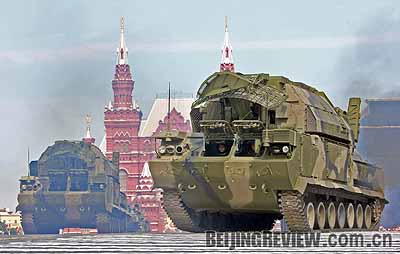|

SHOW OF STRENGTH: Russia shows its heavy weapons in a military arade on May 9, marking the 63rd anniversary of its victory in World War II
In May 2007, the United States launched a plan to deploy an anti-missile system in Eastern Europe, including 10 interceptor missiles in Poland and a radar station in the Czech Republic. Although the system allegedly is being built to counter the threat of a ballistic missile-equipped Iran, the plan has met with vehement opposition from Russia, which insists that the system is directed against it.
Several rounds of high-level consultations have been carried out between Russia and the United States to settle the dispute. At the G8 Summit last June, former Russian President Vladimir Putin made a proposal to his U.S. counterpart George W. Bush that the United States share data from the Gabala radar station in Azerbaijan with Russia instead of building a new radar system in the Czech Republic. The two countries' ministers of foreign affairs and defense met in Moscow last November in an attempt to iron out their differences in America's deployment of an anti-missile system in Eastern Europe and other issues. More talks have been held between the two countries this year. Despite all these negotiations, no substantial agreements have been reached.
Long-term contention
The competition between the United States and the former Soviet Union, now Russia, over missile defense epitomizes the long battle for strategic balance between the two countries. During the Cold War, the strategic forces of the two powers were largely in balance. As they sought to gain a strategic advantage, both were engaged in a nuclear arms race and vied to develop anti-missile interception systems. In order to avoid excessive costs inflicted by an endless nuclear arms race, the two sides concluded a number of treaties to restrict or reduce the number of strategic weapons, including Strategic Arms Limitation Treaty I (SALT I), SALT II, Strategic Arms Reduction Treaty, Strategic Offensive Reduction Treaty and Anti-Ballistic Missile (ABM) Treaty.
Russia's strategic nuclear arsenal has greatly declined since the end of the Cold War. Its conventional weapons are also no match for those of the United States in both quality and quantity. In this context, Russia is giving greater scope to the role of strategic nuclear forces in national security. A case in point is its efforts to improve and extend the service life of old strategic nuclear missiles such as SS-18s and SS-19s and to develop a new silo-based SS-27 missile and a new sea-based Bulava missile.
| 